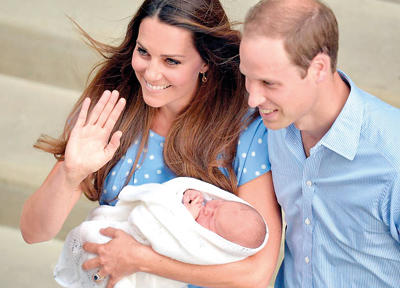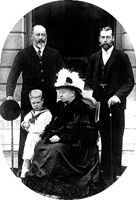What’s in a name? A lot if you are a Royal
Of all the aspects of our identity, the most indelible is our name, confirmed in baptism (and, in time, perhaps, confirmation). For a Christian prince in direct line to the throne it is not only important, but a legal necessity, for without baptism he would not be able to succeed. This is because a sovereign of the United Kingdom is also the Supreme Governor of the Church of England, and as such must be a communicating member of the Established Church.

Prince William and Kate with their baby son outside the Lindo Wing of St. Mary’s Hospital in Central London, July 23 (AFP)
Thus, the baptism of Prince George, on Wednesday, October 23, in St. James’s Palace Chapel, assumes a different and more significant aspect than a mere family or social event. Le Petit Prince will, after all, one day become Le Grand Dauphin.
The choice of names has been a matter of contention in the present Royal Family ever since the christening of the original matriarch, the future Queen Victoria, in 1819.
It is necessary to remember the fraught situation which had occurred in the royal family at that time. George III had only one legitimate grandchild, the Princess Charlotte, daughter of the Prince Regent, and she was of course the heiress to the throne. She had just died in childbirth, and the child had been stillborn. The Regent returned reluctantly from Brighton for the christening in London, where he was to stand godfather. He was not pleased to learn that the other godfather was to be the Tsar of Russia, Alexander I. The baby was the daughter of the Duke of Kent, the Regent’s brother, and his German wife. There had been no discussion beforehand apparently as to the names that the child was to receive. The parents themselves had chosen Victoire Georgina Charlotte Augusta, with possible options of Georgiana and Elizabeth, but the Regent had the veto. In the event he objected to all of them.
All this time, at the ceremony on June 24, 1819, the Archbishop of Canterbury was holding the child over the golden font, waiting. Eventually, after Alexandrina was given as the first name, the Regent spoke ungraciously: “Let her be called after her mother”. So the little mite was named Alexandrina Victoria, and was called “Drina” for the first nine years of her life. Her mother, the Duchess of Kent, began to have doubts about these two “foreign” names in England, but by this time Victoria herself showed great attachment to her name, and herself decided that her mother’s name should be second to none other. When her second uncle became king as William IV, when she was eleven, he himself felt that “the sailors would like her name, and tattoo her face onto their arms, as they would imagine that she had been named after Nelson’s flagship”!! Victoria had arrived.

Four generations of British Monarchs Queen Victoria (1837-1901), Edward VII (1901-1910), George V (1910-1936), and the uncrowned Edward VIII (1936)
Of course the Regent had had his own agenda at the christening and insisted on it being a private ceremony, so that the Kents, whom he disliked, could not make a grand occasion of it. Is there an element of this, one wonders, in the present ceremony, to prevent a similar grand occasion by the rising Middletons?
Things had a similar ring at the baptisms of Queen Victoria’s own children, all nine of them. When the first arrived, she was given at once to be raised by others. The Queen only saw her bathed twice in the first six weeks of her life, and until she was christened, her mother simply referred to her as “the Child”. Distance was the norm at this early stage for Victoria. Even when her daughter was christened, as Victoria Adelaide Mary Louise, in 1840, the Queen called her “Pussy” or “Pussette”.
Queen Victoria was not pleased at having a second child so soon after the first (he arrived eleven and a half months later) but as it was a boy he became the direct heir, and so his christening was also a State occasion, and to the privileged, a public event. His christening was, interestingly, also the last in the Royal family to be in any sense, public, as royal baptisms had usually been in the times of the Tudors, Stuarts, and earlier Hanoverians; but then royal marriages, births and deaths were also public events then. A new age of privacy had arrived after this last public christening.
But the next generation was growing up, and marrying and producing princes and princesses, and the name questions arose again. On the birth of the second son of the Prince of Wales in 1865, (the future George V) it became particularly acute. The Prince had suggested that he be called George Frederick. He wrote to his mother, Queen Victoria, that “they liked the name George, and it is an English one”. His mother did not share this sentiment. “I fear,” she replied, “I cannot admire the names you have chosen to give the baby. …. George only came in with the Hanoverian family” (to whom, incidentally, she owed the throne!) However, if the child grows up good and wise, I shall not mind what his name is. Of course you will add Albert at the end, like your brothers, as you know we settled long ago that all dearest Papa’s male descendants should bear his name, to mark our line, just as I wish all the girls to have Victoria after theirs.
The christening took place on July 7, 1865, at St. George’s Chapel, Windsor, and the future king was duly christened George Frederick Ernst Albert.
A generation forward, the first son of the little prince above was born in 1894. This little boy would one day be Edward VIII, whose brief reign lasted less than a year. However, his birth marked the third generation in the lifetime of Queen Victoria in the direct line. That is partly why the birth of Prince George in 2013 is so significant. Queen Elizabeth II already had two great grand-daughters (the children of her eldest grandson, Peter Phillips) but they were not in the direct line. Now, as in 1894, there are three heirs in the direct line living during the life of the reigning sovereign. This is relatively rare in royal annals.
The next son saw Queen Victoria mollified, for although he inauspiciously arrived on December 14, 1895, the doleful anniversary of Prince Albert’s death, her dutiful grandson asked his grandmother to be godmother, as he was going to be named Albert! The Queen readily agreed, and he was christened on February 17th, 1896, at the Church of St. Mary Magdalene at Sandringham, with the names Albert Frederick Arthur George.
When this prince married in 1923, the bride was Elizabeth Bowes-Lyon, the future Queen Elizabeth and Queen Mother. Her own daughters both presented problems or some initial anxiety with their names. Their father, the future George VI, had grown up a nervous and highly-strung man, with a short fuse. When the first daughter arrived, in 1926,he wrote to his parents, (who had been as distant as Queen Victoria herself sometimes was): “I hope you will approve of these names” (The names chosen for the baby were Elizabeth Alexandra Mary).
The little princess, the future Queen Elizabeth II, was duly christened , when she was five weeks old, in the private chapel of Buckingham Palace, on May 29, 1926. The lily font, which had first been used in 1840, was brought from Windsor to London, filled with water from the River Jordan, duly purified, and the baby wore the cream Brussels lace gown, worn by all royal children since those of Queen Victoria (although occasionally copies have been made). The chapel, like the house in Bruton Street, London, where the future Queen had been born, both became victims of the blitz. The Queen rebuilt the site of the chapel, which is now the Queen’s Gallery.
The eldest son of Princess Elizabeth and her husband, the Duke of Edinburgh, was christened in 1948, and it was marked by a significant gift from his great-grandmother Queen Mary, linking what had been called “The Old Royal Family” with the “New Royal Family”: a silver-gilt cup and cover which George III had given to a godson in 1780: “So I gave a present from my great grandfather to my great grandson 168 years later”.
His elder son, Prince William, the son of Princess Diana, was christened on August 4, 1982, the 82nd birthday of the little prince’s great-grandmother, Queen Elizabeth the Queen Mother, so it was a double celebration, and marked as such. But for his own mother the day was less than enchanting. She later confided: “At William’s christening I was treated like nobody else’s business. Nobody asked me when it was a suitable time for William- 11 0’clock couldn’t have been worse. Endless pictures of the Queen, Queen Mother, Charles and William. I was excluded totally that day. I wasn’t very well, and I just blubbed my eyes out. William started crying too. Well, he just sensed that I wasn’t exactly hunky-dory”.
It may be for this reason that Prince William and his wife, the former Kate Middleton, chose to break with a number of traditions when planning the christening of Prince George, who was born on July 22nd, 2013. Their marriage seems happier in every way and they have chosen the chapel in St. James’s Palace for the christening. This was where Prince William’s mother lay for the night before her funeral in Westminster Abbey the next day, in September, 1997. The Prince and Princess, Duke and Duchess of Cambridge, have made a decision to have a line of their own, while remaining in close touch with other members of their families. Perhaps this is Diana’s legacy, but writ positive.
(The writer is a royal historian who wrote this exclusively to the Sunday Times )
comments powered by Disqus

